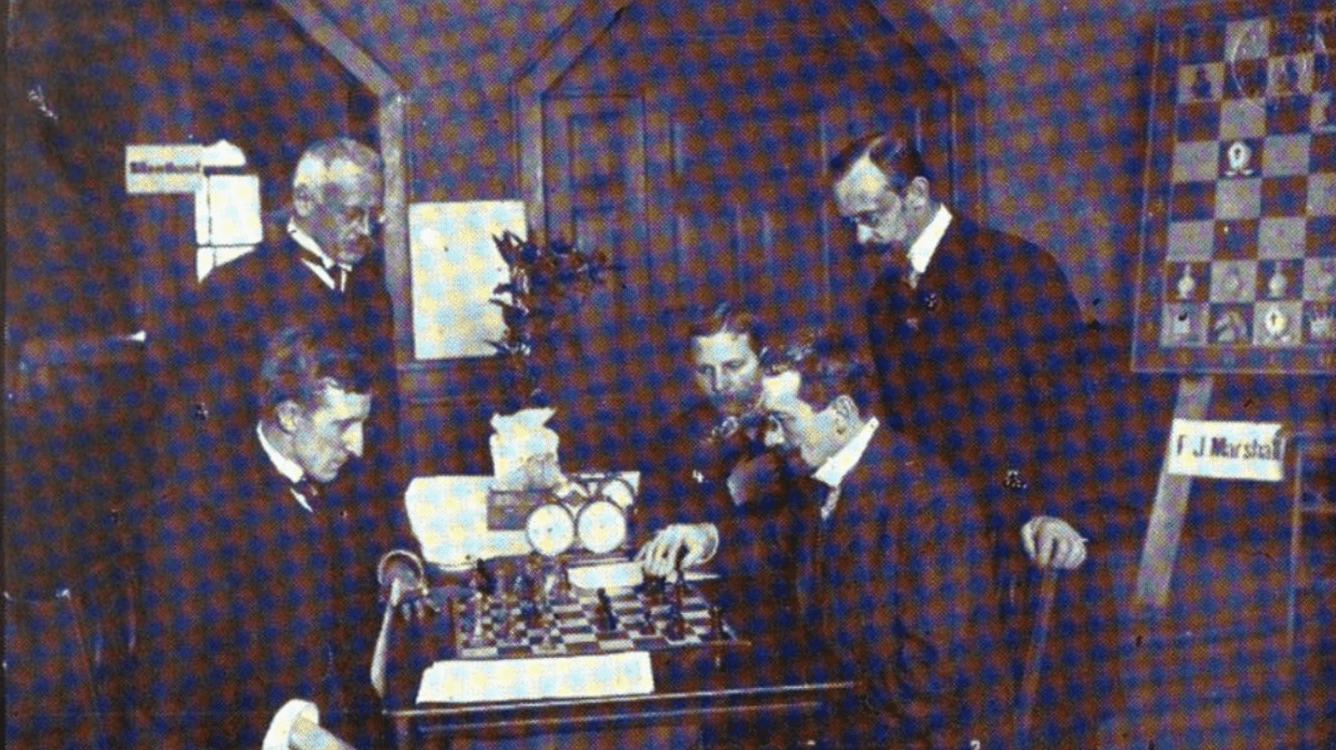
A Century of Chess: Tarrasch-Marshall 1905
If there’s one overarching narrative in my posts up to here – covering the period 1900 to 1905 – it’s the coming of Frank Marshall. 1904-05 was, as he put in his autobiography, ‘the year of years,’ when he won Cambridge Springs, won Monte Carlo Thematic, won Scheveningen, won a match against David Janowski, and suddenly emerged as a viable world championship challenger. But with the Lasker negotiations stalled for money reasons, Marshall agreed to play a match against Siegbert Tarrasch, which acted like a kind of Candidates Semi-Final. Tarrasch had played strongly but very infrequently in tournaments over the last years and had become almost an honorary member of the chess elite – but, to the amazement of the chess world, he stopped Marshall cold, winning the match with the overwhelming score of +8-1=8. Marshall was clearly traumatized by the result – in his otherwise garrulous autobiography he passes over the match in perfect silence, as he does his equally ill-fated 1907 match against Lasker.
The chess world forgave Marshall. The consensus was that he had worn himself out from excessive play over the preceding year. “I was exceedingly fagged at the time,” Marshall conceded, while Lasker wrote that “there is such a thing as too much chess.” Other excuses centered on the unusually slow time control, which took away some of Marshall’s capacity to inject the irrational and psychological into a game. “There was a genuine bit of F.J.” only at one moment in the match, wrote Marshall’s faithful friend Napier.

But the results were so lopsided that they couldn’t be alibied away – Tarrasch’s solid, classical approach defused all of Marshall’s ingenuity. My sense actually is that the match had lasting consequences in chess history – it seemed to prove that ‘adventuring’ might play well in tournaments but couldn’t withstand scrutiny in a long match against the very best in the world. And the combinatorial style espoused by Marshall wouldn’t return at top level really until Bronstein and Tal in the ‘50s (with even Alekhine more or less mimicking Capablanca in their 1927 match).

One of the pleasures of reading chess literature of this era is the spat between Lasker and Tarrasch, the Pale Fire-ish dissection of one another’s annotations. “This note reminds of the mountain that labored and brought forth a mouse,” writes Lasker of one of Tarrasch’s typically pompous notes. Or: “This move which is marked by Tarrasch with an exclamation mark is the one that would most naturally suggest itself.” They are like two colleagues who loathe each other but – except when they can’t really contain themselves – have to preserve an elaborate formality. Still, Lasker was such a great player that he no choice except to recognize the high quality of Tarrasch’s play in this match. “Sound and fearless chess,” he writes of Tarrasch’s queenside castling in the Steinitz French and praises Tarrasch’s “masterful simplicity” in exploiting an apparently minor mistake of Marshall’s. Tarrasch was very unpopular in the chess world at this time - as The British Chess Magazine said directly in print - and I think there was a tendency to underestimate him: these games showcased not only his precise positional understanding but his courage, his willingness to step right into the line of Marshall's attacks and to fight his way through. Tarrasch, not surprisingly, took the match as proof positive that he was the best in the world – and it paved the way, after some difficult negotiations, to his 1908 match with Lasker.
An oddity of the match was the attempt to keep the games and even the result secret until it was over – part of the losing battle that grandmasters have been fighting for a century to make their games their intellectual copyright – with the games issued as part of a book that Tarrasch wrote immediately after the match.
